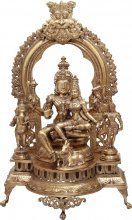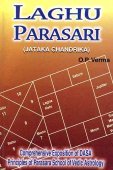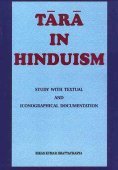Karttika, Kārttika, Kārttikā, Kārtika, Kartika: 27 definitions
Introduction:
Karttika means something in Buddhism, Pali, Hinduism, Sanskrit, Jainism, Prakrit, the history of ancient India, Marathi, Hindi. If you want to know the exact meaning, history, etymology or English translation of this term then check out the descriptions on this page. Add your comment or reference to a book if you want to contribute to this summary article.
Images (photo gallery)
In Hinduism
Purana and Itihasa (epic history)
Source: Cologne Digital Sanskrit Dictionaries: The Purana IndexKārttika (कार्त्तिक).—navami and dvādaśī, as yugādis for śrāddha.*
- * Matsya-purāṇa 17. 4.
Kārttika (कार्त्तिक) is the deity to be worshipped in the month Kārttika for the Anaṅgatrayodaśī-Vrata, according to the 10th century Saurapurāṇa: one of the various Upapurāṇas depicting Śaivism.—Accordingly, the Anaṅgatrayodaśī-vrata is observed in honour of Śiva for acquiring virtue, great fortune, wealth and for destruction of sins [...] This vrata is to be performed for a year from Mārgaśīra.—In the month of Kārttika, the tooth-brush is that of śirīṣa-wood. The food taken is madanaphala. The deity to be worshipped is Kārttika. The flowers used in worship are dūrvāṅkura. The naivedya offerings is different kinds of food. The result accrued equals lusturous like Kāmadeva.

The Purana (पुराण, purāṇas) refers to Sanskrit literature preserving ancient India’s vast cultural history, including historical legends, religious ceremonies, various arts and sciences. The eighteen mahapuranas total over 400,000 shlokas (metrical couplets) and date to at least several centuries BCE.
Vastushastra (architecture)
Source: Wisdom Library: Vāstu-śāstraKārttikā (कार्त्तिका) refers to the fourth of twenty-seven constellations (ṛkṣa), according to the Mānasāra. It is also known by the name Brāhmī. Ṛkṣa is the third of the āyādiṣaḍvarga, or “six principles” that constitute the “horoscope” of an architectural or iconographic object. Their application is intended to “verify” the measurements of the architectural and iconographic object against the dictates of astrology that lay out the conditions of auspiciousness.
The particular nakṣatra, also known as ṛkṣa (e.g., kārttikā) of all architectural and iconographic objects (settlement, building, image) must be calculated and ascertained. This process is based on the principle of the remainder. An arithmetical formula to be used in each case is stipulated, which engages one of the basic dimensions of the object (breadth, length, or perimeter/circumference). In the context of village planning and measurement, the text sates that among the stars (ṛkṣa), the ones that are pūrṇa (odd), are auspicious and the ones that are karṇa (even), inauspicious.

Vastushastra (वास्तुशास्त्र, vāstuśāstra) refers to the ancient Indian science (shastra) of architecture (vastu), dealing with topics such architecture, sculpture, town-building, fort building and various other constructions. Vastu also deals with the philosophy of the architectural relation with the cosmic universe.
Ayurveda (science of life)
Nighantu (Synonyms and Characteristics of Drugs and technical terms)
Source: Wisdom Library: Raj NighantuKārtika (कार्तिक) is the second month of the “autumn season” (śarada) in the traditional Indian calendar, according to the second chapter (dharaṇyādi-varga) of the 13th-century Raj Nighantu or Rājanighaṇṭu (an Ayurvedic encyclopedia). The physician (bhiṣaj) should pay attention to the seasonal (ṛtu) factor in the use of medicinal drugs. Accordingly, “the bulbous roots in winter season (viz., Kārtika), other roots in cold season and flowers during spring season are supposed to contain better properties. The new leaves or shoots in summer and the drugs, which grow in mud, like Lotus etc., should be used in autumn season”.
Toxicology (Study and Treatment of poison)
Source: Shodhganga: Kasyapa Samhita—Text on Visha ChikitsaKārtika (कार्तिक) refers to the “month of Kārttikā”, as taught in the Nāgajanman (“birth of the Snakes”) section of the Kāśyapa Saṃhitā: an ancient Sanskrit text from the Pāñcarātra tradition dealing with both Tantra and Viṣacikitsā—an important topic from Āyurveda which deals with the study of Toxicology (Agadatantra or Sarpavidyā).—Those snakes born in the months of Kārtikā, Mṛgaśīrṣa and Pauṣa are respectively idle, powerful and longest and extremely poisonous.

Āyurveda (आयुर्वेद, ayurveda) is a branch of Indian science dealing with medicine, herbalism, taxology, anatomy, surgery, alchemy and related topics. Traditional practice of Āyurveda in ancient India dates back to at least the first millenium BC. Literature is commonly written in Sanskrit using various poetic metres.
Vaishnavism (Vaishava dharma)
Source: Pure Bhakti: Arcana-dipika - 3rd EditionKārtika (कार्तिक), corresponding to “October-November”, refers to one of the months (māsa) in the Vedic calendar.—There are twelve months in a Vedic lunar calendar, and approximately every three years, there is a thirteenth month. Each month has a predominating deity and approximately corresponds with the solar christian months. [...] In accordance with the month of the year, one would utter the Vedic month, for example, kārtika-māsi.
The presiding deity of Kārtika is Dāmodara.

Vaishnava (वैष्णव, vaiṣṇava) or vaishnavism (vaiṣṇavism) represents a tradition of Hinduism worshipping Vishnu as the supreme Lord. Similar to the Shaktism and Shaivism traditions, Vaishnavism also developed as an individual movement, famous for its exposition of the dashavatara (‘ten avatars of Vishnu’).
Kavya (poetry)
Source: OpenEdition books: Vividhatīrthakalpaḥ (Kāvya)Kārtika (कार्तिक) refers to Kattiya: the name of an ancient merchant mentioned in the Vividhatīrthakalpa by Jinaprabhasūri (13th century A.D.): an ancient text devoted to various Jaina holy places (tīrthas).—Accordingly, “In Hastināpura lives a śivaïte ascetic, very honored by all for his austerities, except the merchant Kārtika, of Jaina obedience. The ascetic dreams of revenge: invited one day to break his fast with King Jitaśatru, he accepts on condition that Kārtika waits for him. Forced, Kārtika complies with the request, while regretting not having become a monk before. The humiliation which the ascetic inflicts on him, moreover, disgusts him in the world: he becomes a monk with ten thousand other merchants”.
Cf. Āvaśyakacūrṇi II 276.12-277.4; Āvasyakaniryukti (Haribhadra commentary) 81 lb. 1 l-a.8.

Kavya (काव्य, kavya) refers to Sanskrit poetry, a popular ancient Indian tradition of literature. There have been many Sanskrit poets over the ages, hailing from ancient India and beyond. This topic includes mahakavya, or ‘epic poetry’ and natya, or ‘dramatic poetry’.
Jyotisha (astronomy and astrology)
Source: Wisdom Library: Brihat Samhita by VarahamihiraKārttika (कार्त्तिक) refers to the months October-November (when the full moon is in the asterism of Kṛttikā), according to the Bṛhatsaṃhitā (chapter 5), an encyclopedic Sanskrit work written by Varāhamihira mainly focusing on the science of ancient Indian astronomy astronomy (Jyotiṣa).—Accordingly, “If there should be both lunar and solar eclipses in one month, princes will suffer both from dissensions among their own army and from wars. [...] If the solar or lunar eclipse should fall in the lunar month of Kārttika, persons who live by fire, the Magadhas, the eastern princes, the Kosalas, the Kalmāṣas, the Śūrasenas and the people of Benares will suffer miseries; the ruler of Kaliṅga with his ministers and servants and the Kṣatriyas will perish but there will be prosperity and plenty in the land”.

Jyotisha (ज्योतिष, jyotiṣa or jyotish) refers to ‘astronomy’ or “Vedic astrology” and represents the fifth of the six Vedangas (additional sciences to be studied along with the Vedas). Jyotisha concerns itself with the study and prediction of the movements of celestial bodies, in order to calculate the auspicious time for rituals and ceremonies.
In Buddhism
Tibetan Buddhism (Vajrayana or tantric Buddhism)
Source: archive.org: The Indian Buddhist IconographyKārttika (कार्त्तिक) (presided over by Brahmā) is the eighth of twelve months, as commonly depicted in Buddhist Iconography, and mentioned in the 11th-century Niṣpannayogāvalī of Mahāpaṇḍita Abhayākara.—Accordingly, there are altogether twelve months [viz., Kārttika] having twelve deities as given in the kālacakra-maṇḍala.—“here they are all accompanied with their Śaktis, mostly four-armed and have their distinctive vehicles”.
Source: OSU Press: Cakrasamvara SamadhiKartika (कर्तिक) refers to a “flaying knife” which is used to describe Cakrasaṃvara, according to the Saṃvaramaṇḍala of Abhayākaragupta’s Niṣpannayogāvalī, p. 45 and n. 145; (Cf. Cakrasaṃvaratantra, Gray, David B., 2007).—Accordingly, [while describing the iconography of Cakrasaṃvara]: “In the Saṃvara Maṇḍala atop Mount Sumera within a vajra-canopy there is a variegated lotus, on top of that a palace, in the middle of which is the Blessed Lord, standing in ālīḍhāsana, "archer's pose", [...] possessing a vyāghracarma, "tiger skin" and twelve arms, the foremost arms holding a vajra and ghaṇṭā, embracing Vajravārāhī, the uppermost arms holding a gajacarman, "elephant skin", dripping with blood, the remaining arms holding, starting second from the top, on the right, a ḍamaru, "double-headed drum", paraśu, "axe", kartika, "flaying knife", triśūla, "trident", on the left, a khaṭvāṅga, "staff", kapāla, "skull bowl", pāśa, "noose", and brahmamuṇḍa, "lopped head of Brahma", [...]”.
Note: [For Cakrasaṃvara]—The kartika, "flaying knife", symbolizes cutting away the pañca-nivāraṇa, "The Five Hindrances": 1) kāmacchanda "sensual desire" 2) vyāpāda "evil intent" 3) styānamiddha "laziness-lethargy" 4) auddhatyakaukṛitya "restlessness-regret" 5) vicikitsā "indecision".—[For Vajravārāhī and Vajrayoginī]—Spinning the kartika, "flaying knife", in the ten directions symbolizes śūnyatā-prajñā, "wisdom of emptiness", which cuts away all conceptual thought. (Also see the pañca-nivāraṇa, "The Five Hindrances")
Source: MDPI Books: The Ocean of HeroesKarttikā (कर्त्तिका) refers to a “knife” (i.e., one of the attributes held in the hands of a deity), according to the 10th-century Ḍākārṇava-tantra: one of the last Tibetan Tantric scriptures belonging to the Buddhist Saṃvara tradition consisting of 51 chapters.—Accordingly, “[...] [He (The Causal Vajra-holder)] stands in the ālīḍha posture with the feet placed on both Hara and Gaurī [He holds] (1) a vajra and (2) a bell, (3)(4) an elephant’s skin, (5) a drum, (6) a knife (karttikā), (7) an axe, (8) a trident, (9) a skull staff, (10) a pot, (11) a noose, and (12) a hairless head in the left and right [hands]. [...]”.

Tibetan Buddhism includes schools such as Nyingma, Kadampa, Kagyu and Gelug. Their primary canon of literature is divided in two broad categories: The Kangyur, which consists of Buddha’s words, and the Tengyur, which includes commentaries from various sources. Esotericism and tantra techniques (vajrayāna) are collected indepently.
In Jainism
General definition (in Jainism)
Source: archive.org: TrisastisalakapurusacaritraKārtika (कार्तिक) is the name of a Jain layman from Hastināpura, according to chapter 6.7 [śrī-munisuvratanātha-caritra] of Hemacandra’s 11th century Triṣaṣṭiśalākāpuruṣacaritra: an ancient Sanskrit epic poem narrating the history and legends of sixty-three illustrious persons in Jainism.
Accordingly:—“After he had finished his sermon, wishing to benefit the world, the Lord stopped one day in his wandering in Hastināpura. In this city Jitaśatru was king and there was a Jain layman, Kārtika, a merchant, the head of a thousand merchants. There was in the city a Vaiṣṇavite ascetic, wearing reddish garments, who fasted for a month at a time and was much worshipped by the citizens. At each fast-breaking he was invited by the people with great devotion, but not by the merchant Kārtika whose supreme treasure was right-belief. [...]”.

Jainism is an Indian religion of Dharma whose doctrine revolves around harmlessness (ahimsa) towards every living being. The two major branches (Digambara and Svetambara) of Jainism stimulate self-control (or, shramana, ‘self-reliance’) and spiritual development through a path of peace for the soul to progess to the ultimate goal.
India history and geography
Source: Cologne Digital Sanskrit Dictionaries: Indian Epigraphical GlossaryKārttika.—(CITD), crops reaped in the month of Kārttika. Note: kārttika is defined in the “Indian epigraphical glossary” as it can be found on ancient inscriptions commonly written in Sanskrit, Prakrit or Dravidian languages.

The history of India traces the identification of countries, villages, towns and other regions of India, as well as mythology, zoology, royal dynasties, rulers, tribes, local festivities and traditions and regional languages. Ancient India enjoyed religious freedom and encourages the path of Dharma, a concept common to Buddhism, Hinduism, and Jainism.
Languages of India and abroad
Marathi-English dictionary
Source: DDSA: The Molesworth Marathi and English Dictionarykārttika (कार्त्तिक).—m (S kṛttikā Pleiades.) The eighth Hindu month, October-November; when the moon is full near the Pleiades.
Source: DDSA: The Aryabhusan school dictionary, Marathi-EnglishKārtika (कार्तिक).—m The 8th Hindu month.
Marathi is an Indo-European language having over 70 million native speakers people in (predominantly) Maharashtra India. Marathi, like many other Indo-Aryan languages, evolved from early forms of Prakrit, which itself is a subset of Sanskrit, one of the most ancient languages of the world.
Sanskrit dictionary
Source: DDSA: The practical Sanskrit-English dictionaryKārtika (कार्तिक).—a. (-kī f.) [कृत्तिका-अण् (kṛttikā-aṇ)] Belonging to the month of Kārtika; कार्तिकीषु सवितानहर्म्यभाक् (kārtikīṣu savitānaharmyabhāk) R.19.39.
-kaḥ 1 Name of the month in which the full moon is near the कृत्तिका (kṛttikā) or Pleiades (corresponding to OctoberNovember).
2) An epithet of Skanda.
-kī The full moon day in the month of Kārtika (Mar. tripurī paurṇimā). कार्तिक्याः प्रभृति आग्रहायणी मासे (kārtikyāḥ prabhṛti āgrahāyaṇī māse) Mahābhārata on P.II. 3.28.
Source: Cologne Digital Sanskrit Dictionaries: Shabda-Sagara Sanskrit-English Dictionary
Kārttika (कार्त्तिक).—m.
(-kaḥ) 1. The month Kartik, (October-November,) when the moon is full near the Pleiades. 2. The deity Kartikeya. E. kṛttikā the Pleiades, aṇ aff.
Source: Cologne Digital Sanskrit Dictionaries: Benfey Sanskrit-English DictionaryKārttika (कार्त्तिक).—i. e. kṛttikā + a, I. m. The name of a month (October- November), Mahābhārata 2, 918. Ii. f. kī, The day of this month on which the moon is full, Mahābhārata 3, 4073.
Source: Cologne Digital Sanskrit Dictionaries: Cappeller Sanskrit-English DictionaryKārttika (कार्त्तिक).—[masculine] a cert. month in autumn, also = seq.
Source: Cologne Digital Sanskrit Dictionaries: Aufrecht Catalogus CatalogorumKārttika (कार्त्तिक) as mentioned in Aufrecht’s Catalogus Catalogorum:—a medical writer. Quoted by Bhāvamiśra Oxf. 311^b, by Mādhava Oxf. 314^b.
Source: Cologne Digital Sanskrit Dictionaries: Monier-Williams Sanskrit-English Dictionary1) Karttikā (कर्त्तिका):—f. a dagger, [Hemacandra’s Pariśiṣṭaparvan]
2) Kārttika (कार्त्तिक):—m. ([from] kṛttikā q.v.; with or without māsa), Name of a month corresponding to part of October and November (the twelfth month of the year, when the full moon is near the Pleiades), [Pāṇini; Lāṭyāyana; Mahābhārata] etc.
3) Name of Skanda (See kārttikeya), [Brahma-purāṇa]
4) of a Varṣa
5) of a medical author
6) mn. Name of the first year in Jupiter’s period of revolution, [Varāha-mihira’s Bṛhat-saṃhitā; Sūryasiddhānta]
7) n. Name of a Tīrtha, [Matsya-purāṇa]
Source: Cologne Digital Sanskrit Dictionaries: Yates Sanskrit-English DictionaryKārttika (कार्त्तिक):—(kaḥ) 1. m. The month Kārtik (October-November).
Source: DDSA: Paia-sadda-mahannavo; a comprehensive Prakrit Hindi dictionary (S)Kārttika (कार्त्तिक) in the Sanskrit language is related to the Prakrit words: Kattiya, Kattiyā.
[Sanskrit to German]
Sanskrit, also spelled संस्कृतम् (saṃskṛtam), is an ancient language of India commonly seen as the grandmother of the Indo-European language family (even English!). Closely allied with Prakrit and Pali, Sanskrit is more exhaustive in both grammar and terms and has the most extensive collection of literature in the world, greatly surpassing its sister-languages Greek and Latin.
Hindi dictionary
Source: DDSA: A practical Hindi-English dictionaryKārtika (कार्तिक) [Also spelled kartik]:—(nm) see [kātika].
...
Kannada-English dictionary
Source: Alar: Kannada-English corpusKārtika (ಕಾರ್ತಿಕ):—
1) [noun] the eighth month of lunar calendar year.
2) [noun] a festival during this month observed in temples.
3) [noun] Skanda, the son of Śiva.
--- OR ---
Kārtīka (ಕಾರ್ತೀಕ):—[noun] = ಕಾರ್ತಿಕ - [kartika -] 1; [wrong form of ಕಾರ್ತಿಕ [kartika]].
Kannada is a Dravidian language (as opposed to the Indo-European language family) mainly spoken in the southwestern region of India.
See also (Relevant definitions)
Starts with (+12): Karttikabijakavaca, Karttikai-tevimar, Karttikaiccampa, Karttikaikkacu, Karttikaikkanikkai, Karttikaikkilanku, Karttikaikkolli, Karttikaippaccai, Karttikaippori, Karttikaivalai, Karttikaivaratti, Karttikaivilakkitu, Karttikaivilakku, Karttikaiyarici, Karttikakunda, Karttikamahatmya, Karttikamahatmyakshemamkari, Karttikamahatmyasamgraha, Karttikamahiman, Karttikamasa.
Ends with: Parikarttika, Svamikarttika.
Full-text (+313): Kattiya, Kaumuda, Karttiki, Karttikotsava, Yamadvitiya, Tulasivivaha, Prabodhini, Mahakarttiki, Skandashashthi, Karttikika, Bhratridvitiya, Karttikamahiman, Utthanaikadashi, Tamalakartika, Yaksharatri, Bhutacaturdashi, Gopashtami, Durganavami, Gosahasri, Dyutapratipad.
Relevant text
Search found 92 books and stories containing Karttika, Kārttika, Kārttikā, Kārtika, Kartika, Kārtīka, Karttikā, Kartīka; (plurals include: Karttikas, Kārttikas, Kārttikās, Kārtikas, Kartikas, Kārtīkas, Karttikās, Kartīkas). You can also click to the full overview containing English textual excerpts. Below are direct links for the most relevant articles:
Garga Samhita (English) (by Danavir Goswami)
Verse 5.20.28 < [Chapter 20 - The Liberation of Ṛbhu Muni During the Rāsa-dance Festival]
Verses 6.15.12-14 < [Chapter 15 - The Glories of Nṛga-kūpa and Gopī-bhūmi]
Verses 3.10.31-37 < [Chapter 10 - The Glory of Śrī Girirāja]
Manusmriti with the Commentary of Medhatithi (by Ganganatha Jha)
Verse 4.119 < [Section XIII - Days unfit for Study]
Verse 4.69 < [Section IX - Personal Cleanliness]
Verse 3.274 < [Section XXI - Relative Merits of the Offering-Materials]
The Vishnu Purana (by Horace Hayman Wilson)
2. The Padma Purāṇa < [Preface]
Chapter XIV - Of occasional Shraddhas, or obsequial ceremonies < [Book III]
Chapter XIII - Herdsmen appraised Krishna < [Book V]
Amarakoshodghatana of Kshirasvamin (study) (by A. Yamuna Devi)
Units of time < [Chapter 3 - Social Aspects]
The Garuda Purana (by Manmatha Nath Dutt)
Chapter CXXIII - Kartika Vratas < [Brihaspati (Nitisara) Samhita]
Chapter CXXII - The Masopavasa Vratam < [Brihaspati (Nitisara) Samhita]
Chapter CXXXVII - The Damanaka Tryodasi Vratas < [Brihaspati (Nitisara) Samhita]
The Padma Purana (by N.A. Deshpande)
Chapter 94 - Restraints during the Kārtika Vow < [Section 6 - Uttara-Khaṇḍa (Concluding Section)]
Chapter 118 - Śiva Answers Kārtikeya’s Queries < [Section 6 - Uttara-Khaṇḍa (Concluding Section)]
Chapter 3 - The Importance of Offering a Lamp to Viṣṇu < [Section 4 - Brahma-khaṇḍa (Section on Brahman)]
Related products


